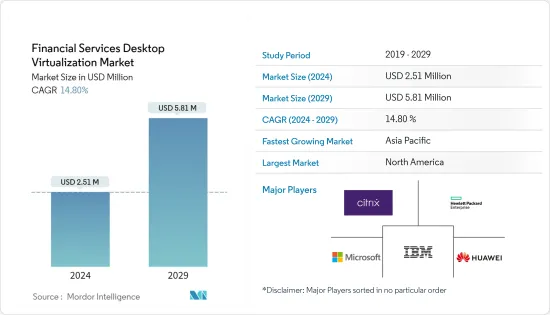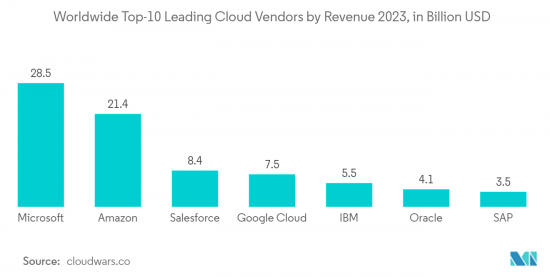PUBLISHER: Mordor Intelligence | PRODUCT CODE: 1403865

PUBLISHER: Mordor Intelligence | PRODUCT CODE: 1403865
Financial Services Desktop Virtualization - Market Share Analysis, Industry Trends & Statistics, Growth Forecasts 2024 - 2029

The Financial Services Desktop Virtualization Market size is estimated at USD 2.51 million in 2024, and is expected to reach USD 5.81 million by 2029, growing at a CAGR of 14.80% during the forecast period (2024-2029).
Enterprises are concentrating on working remotely to make their employees more effective and productive. Moreover, remote working and cloud processing could lower the cost of IT equipment. Clouds have evolved as an infrastructure, allowing for rapidly distributing processing resources as a service in a dynamically scalable and virtualized environment. The use of desktop virtualization is driven by higher cloud uptake rates and corporate preferences for implementing computers on the cloud.
Key Highlights
- Financial organizations frequently have numerous user categories or personas. Each user identity requires a distinct computer desktop image within the organization. These characters include front-office and branch employees such as tellers, customer support reps, and knowledge workers.
- So, for many financial organizations, designing a high-performance, scalable, and cost-effective VDI infrastructure that can support these multiple FSI personas, as well as meet seasonal demand spikes, provide disaster recovery (DR), and respond quickly to unexpected regional and global events or disasters, is a real challenge.
- IT teams find that the design, deployment, configuration, and management of professional graphics VDI platforms for applications that have previously run on physical workstations is becoming increasingly difficult in view of changing workforce dynamics, rising demand for virtual infrastructures as well as a variety of user types within the FSI sector.
- Different organizations may have vastly different requirements in terms of the type of IT infrastructure that is best suited to their specific needs, which can range from hyper-converged infrastructure (HCI) to converged infrastructure (CI) to standard three-tier designs that can define and scale the compute and storage components on your own.
- Moreover, The rising adoption trends of desktop virtualization across various financial sectors drive market growth. Many banking organizations are moving away from the conventional PC path with the hard drive towards desktop virtualization. Financial institutions to make the transition frequently implement a Virtual Desktop Infrastructure (VDI). This server computing paradigm allows desktop virtualization and includes the hardware and software systems required to support the environment.
- Further, simplicity in management, measuring, and monitoring are a few factors driving desktop virtualization in financial services. Moreover, the enhanced data security benefits the firms in the increased adoption of virtualization. Virtual computers cannot be taken, abandoned, or physically compromised. A disconnected virtual desktop no longer appears at the distant site, closing the site's most vulnerable security gap: the computer itself.
- However, configuring and implementing desktop virtualization is challenging due to the numerous complexities and interoperability problems. Before adopting desktop virtualization solutions, it is essential to analyze the infrastructure needs, such as server capacity, network bandwidth, and workload. Several times, a user compromises on the necessary infrastructure configuration and attempts to implement a desktop virtualization solution on the current infrastructure, which may further hamper the effectiveness of the implemented solution. Furthermore, qualified workers are scarce in the industry.
- Further, the COVID-19 pandemic strengthened the demand for financial services companies to move their virtual desktop networks (VDIs) to the cloud.
Financial Services Desktop Virtualization Market Trends
Increasing Adoption of Cloud Services in Financial Institutions to Drive the Market Growth
- As financial services companies are increasingly adopting a cloud-first approach to new applications, demand for cloud-based services increased as well in the virtualization market. Moreover, most financial services firms are already utilizing some type of public cloud. According to the Google Cloud survey, a significant percentage of surveyed financial services firms (83%) report that businesses are using cloud technology as part of their main computing platforms. The most common cloud design is hybrid cloud (38%), followed by single cloud (28%) and multi-cloud (17%). Notably, 88% of respondents without a multi-cloud implementation said they plan to implement a multi-cloud plan in the next 12 months.
- According to the global 2022 Enterprise Cloud Index (ECI) released recently by Nutanix, a prominent player in enterprise cloud computing, Almost all financial services respondents (98%) have migrated one or more apps to a new IT environment in the last 12 months, most likely from conventional datacenters to private clouds, given the industry's low multi-cloud and public cloud penetration. Moreover, the American Bankers Association reported that more than 90% of financial organizations use cloud tools for some or all of their banking activities.
- Further, application streaming over the cloud is gaining popularity in the industry, with many enterprises choosing standalone application services. Cloud is preferred across sectors, as it provides better scalability, data management, and cost savings.
- Moreover, the deployment of cloud makes it easy for information to move between working environments. They may also make use of the ability to scale up their requirements and purchase additional computing power and data without having to install a physical server. More effective management of resources is enabled by this flexibility.
- Furthermore, infrastructure for virtual desktops necessitates extra storage, operational bandwidth, and software, which might require the purchase of expensive SANs and servers to house and operate hundreds of computers. VDI implementation and maintenance costs can be reduced in public cloud settings that include built-in VDI options.
- Due to the available additional layer of security, it also provides data and applications while ensuring that user experiences are maximized; desktop virtualization as a cloud service is an especially attractive option in BFSI. The primary issue of financial services remains the data security problem, which continues to be one of the main reasons why desktop virtualization is being adopted in this sector.

Asia-Pacific to Register Significant Growth Rates During the Forecast Period
- The rapid digitization of company processes, as well as the growing demand for cloud-based computing options that can enhance enterprise data protection, are a few factors driving the market in the region. Additionally, the increasing utilization of safe remote access and mobile devices propels the Asia Pacific desktop virtualization business forward.
- In the financial services industry, Asia hosts some prominent IT outsourcing destinations for a number of market players. It is expected that many emerging markets in the region will also experience higher growth rates than those of the mature economies.
- As these markets continue to grow in this trajectory, the need for financial services, such as retail banking, asset management, insurance, capital market service, and others, is also increasing. Many industry players have been increasing their presence in the region to capture the market in this fast-growing region.
- Furthermore, financial organizations in the area are increasingly turning to specialized desktop virtualization solutions to reduce hardware and maintenance expenses and ease IT administration operations. This has resulted in the fast adoption of desktop virtualization options such as Citrix XenDesktop, VMware Horizon View, and Microsoft Remote Desktop Services (RDS). Furthermore, the growing demand for better user experience and efficiency propels the Asia Pacific desktop virtualization market.
- The growing tendency of remote work and the need to provide workers with seamless access to work programs and data from any location has led to the adoption of Desktop Virtualization technology by organizations. This effectively solved the problem of workers' restricted geographic accessibility, increasing their productivity and allowing more effective organizational decision-making. Furthermore, the market's expansion has been anticipated to be fueled by the growing popularity of Bring Your Own Device (BYOD) and Workplace-as-a-Service (WaaS) among businesses in the area.
Financial Services Desktop Virtualization Industry Overview
The financial services desktop virtualization market is a competitive market with prominent players like Citrix Systems, Inc., Toshiba Corporation, IBM Corporation, Microsoft Corporation, and Huawei Technologies Co. Ltd, among others. To increase their footprint, most of the significant players are signing long-term agreements with Financial Institutions and providing customized solutions based on the needs of the clientele.
In December 2022, Nerdio, the primary solution for organizations seeking to implement virtual desktops employing native Microsoft technologies, reported the completion of a USD 117 million Series B financing round led by Updata Partners, a prominent growth equity firm. Nerdio added value to Azure Virtual Desktop, Windows 365, and Microsoft Intune by providing hundreds of features to ease administration, assisting business organizations and partners in modernizing their DaaS projects and delivery methods.
In November 2022, VMware unveiled enhanced features across its Anywhere Workspace platform to help IT teams reduce administrative burdens and increase efficiency through automation. VMware Anywhere Workspace allowed flexible work through the use of Unified Endpoint Management (UEM), VDI and DaaS, Digital Employee Experience (DEX), and Workspace Security.
Additional Benefits:
- The market estimate (ME) sheet in Excel format
- 3 months of analyst support
TABLE OF CONTENTS
1 INTRODUCTION
- 1.1 Study Assumptions and Market Definition
- 1.2 Scope of the Study
2 RESEARCH METHODOLOGY
3 EXECUTIVE SUMMARY
4 MARKET INSIGHTS
- 4.1 Market Overview
- 4.2 Industry Value Chain Analysis
- 4.3 Industry Attractiveness - Porter's Five Forces Analysis
- 4.3.1 Bargaining Power of Suppliers
- 4.3.2 Bargaining Power of Buyers/Consumers
- 4.3.3 Threat of New Entrants
- 4.3.4 Threat of Substitute Products
- 4.3.5 Intensity of Competitive Rivalry
- 4.4 Assessment of the Impact of COVID-19 on the Market
5 MARKET DYNAMICS
- 5.1 Market Drivers
- 5.1.1 Increasing Adoption of Cloud Services in Financial Institutions
- 5.1.2 Desktop Virtualization Supports Inorganic Growth
- 5.2 Market Restraints
- 5.2.1 Infrastructural Constraints of Enterprises will Act as a Challenge for the Growth of the Market
- 5.2.2 Lack of Skilled Professionals
6 MARKET SEGMENTATION
- 6.1 By Desktop Delivery Platform
- 6.1.1 Hosted Virtual Desktop (HVD)
- 6.1.2 Hosted Shared Desktop (HSD)
- 6.1.3 Other Desktop Delivery Platform
- 6.2 By Deployment Mode
- 6.2.1 On-premises
- 6.2.2 Cloud
- 6.3 By Geography
- 6.3.1 North America
- 6.3.2 Europe
- 6.3.3 Asia-Pacific
- 6.3.4 Latin America
- 6.3.5 Middle East & Africa
7 COMPETITIVE LANDSCAPE
- 7.1 Company Profiles
- 7.1.1 Citrix Systems, Inc.
- 7.1.2 Hewlett Packard Enterprise Development LP
- 7.1.3 IBM Corporation
- 7.1.4 Microsoft Corporation
- 7.1.5 Huawei Technologies Co. Ltd
- 7.1.6 Evolve IP, LLC
- 7.1.7 Parallels International GmbH (Corel Corporation)
- 7.1.8 Dell Inc.
- 7.1.9 NComputing Co., Ltd.
- 7.1.10 Ericom Software Ltd.
8 INVESTMENT ANALYSIS
9 MARKET OPPORTUNITIES AND FUTURE TRENDS




